
The Mojave Desert is a xeric desert in the rain shadow of the Sierra Nevada mountains in the Southwestern United States. It is named for the indigenous Mojave people. It is located primarily in southeastern California and southwestern Nevada, with small portions extending into Arizona and Utah.

Papaver somniferum, commonly known as the opium poppy or breadseed poppy, is a species of flowering plant in the family Papaveraceae. It is the species of plant from which both opium and poppy seeds are derived and is also a valuable ornamental plant, grown in gardens. Its native range is probably the eastern Mediterranean, but is now obscured by ancient introductions and cultivation, being naturalized across much of Europe and Asia.
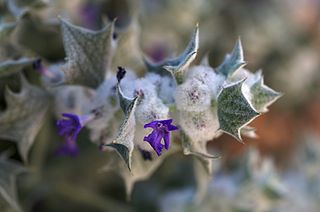
Salvia funerea, is a species of semi-deciduous perennial shrub with the common names Death Valley sage, woolly sage, and funeral sage, is an intricately branched shrub associated with limestone soils in the Mojave Desert in California and Nevada. It is characterized by an overall white appearance due to wooly hairs that cover the stems and leaves.

Chaenactis xantiana, the Mojave pincushion or Xantus pincushion, is a flowering plant in the family Asteraceae, native to the western United States, from southeastern Oregon, Nevada, southern and eastern California and northwestern Arizona. It is very common in the Antelope Valley in the Mojave Desert, and grows in sandy soils.
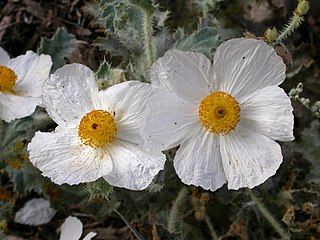
Argemone corymbosa, the Mojave prickly poppy, is a flowering plant in the family Papaveraceae native to the eastern Mojave Desert of the southwestern United States. It especially common around Cima, California and the nearby community of Kelso, California. The plant grows in sandy places and on dry slopes, and is very similar to desert prickly poppy.

Banksia serrata, commonly known as the saw banksia, the old man banksia, the saw-tooth banksia or the red honeysuckle and as wiriyagan by the Cadigal people, is a species of woody shrub or tree of the genus Banksia, in the family Proteaceae. Native to the east coast of Australia, it is found from Queensland to Victoria with outlying populations on Tasmania and Flinders Island. Commonly growing as a gnarled tree up to 16 m (50 ft) in height, it can be much smaller in more exposed areas. This Banksia species has wrinkled grey bark, shiny dark green serrated leaves and large yellow or greyish-yellow flower spikes appearing over summer. The flower spikes, or inflorescences, turn grey as they age and pollinated flowers develop into large, grey, woody seed pods called follicles.

Banksia aculeata, commonly known as prickly banksia, is a species of plant of the family Proteaceae native to the Stirling Range in the southwest of Western Australia. A shrub up to 2 m (7 ft) tall, it has dense foliage and leaves with very prickly serrated margins. Its unusual pinkish, pendent (hanging) flower spikes, known as inflorescences, are generally hidden in the foliage and appear during the early summer. Although it was collected by the naturalist James Drummond in the 1840s, Banksia aculeata was not formally described until 1981, by Alex George in his monograph of the genus.
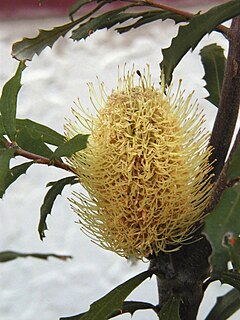
Banksia canei, commonly known as the mountain banksia, is a species of shrub that is endemic to southeastern Australia. It is generally encountered as a many-branched shrub that grows up to 3 m (10 ft) high, with narrow leaves and the yellow inflorescences appearing from late summer to early winter. The old flowers fall off the spikes, and up to 150 finely furred follicles develop, which remain closed until burnt in a bushfire. Each follicle bears two winged seeds. Response to fire is poorly known, although it is thought to regenerate by seed. Birds such as the yellow-tufted honeyeater and various insects forage among the flower spikes. It is frost tolerant in cultivation, but copes less well with aridity or humidity, and is often short-lived in gardens. One cultivar, Banksia 'Celia Rosser', was registered in 1978, but has subsequently vanished.
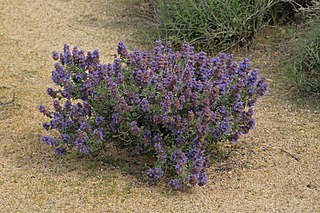
Salvia dorrii, the purple sage, Dorr's sage, fleshy sage, mint sage, or tobacco sage, is a perennial spreading shrub in the family Lamiaceae. It is native to mountain areas in the western United States and northwestern Arizona, found mainly in the Great Basin and southward to the Mojave Desert, growing in dry, well draining soils.

Castilleja exserta is a species of plant in the genus Castilleja which includes the Indian paintbrushes. Its common names include purple owl's clover, escobita, and exserted Indian paintbrush.

Argemone munita is a species of prickly poppy known by the common names flatbud prickly poppy and chicalote. "Munita" means "armed", in reference to the many long prickles. This flower is native to California, where it is widespread throughout the western part of the state and its eastern deserts, on slopes to 10,000 feet, and along roadsides. Its range also extends into Baja California, Arizona, and Nevada.

Atriplex hymenelytra, the desert holly, is silvery-whitish-gray shrub in the family Amaranthaceae, native to deserts of the southwestern United States. It is the most drought tolerant saltbush in North America. It can tolerate the hottest and driest sites in Death Valley, and remains active most of the year.

Arctomecon merriamii is a species of poppy known by several common names, including desert bearpoppy, white bearpoppy, and great bearclaw poppy. It is native to the Mojave Desert of California and Nevada.

Arctomecon humilis is a rare species of poppy called bearclaw poppy or dwarf bearclaw-poppy. It is endemic to Washington County, Utah, in the United States of America. It is a federally listed endangered species limited to barren, heavily gypsiferous soils in the immediate vicinity of St. George, Utah. Only a half-dozen populations are known, several of which are adjacent to or even within the urbanized area.
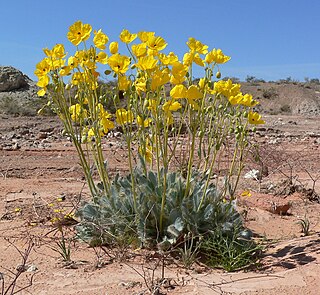
Arctomecon californica is a species of poppy known by several common names, including California bearpoppy, Las Vegas bearpoppy, golden bearpoppy, and yellow-flowered desert poppy.

Grevillea heliosperma, commonly known as the rock grevillea, is a shrub native to northern Australia, generally growing around 3 to 5 m tall, rarely to 8 m (26 ft). It has red flowers.

Pediocactus sileri is a rare species of cactus known by the common names Siler's pincushion cactus and gypsum cactus. It is native to southwestern Utah and northwestern Arizona in the United States. It is limited to a specific type of soil, individuals are often spaced far apart, and the species is threatened by a number of human activities such as off-road vehicle use, poaching, and uranium mining. This is a federally listed threatened species of the United States.

Meconopsis horridula, the prickly blue poppy, is a flowering plant from the family Papaveraceae. It is an endangered species that grows in high altitudes. The height of the plant varies from 20 cm to 1m. It is a monocarpic, dicot plant.

Hilaria rigida is a species of clumping perennial grass that is widespread in California deserts. It is commonly known as big galleta. It is a monocot in the Hilaria genus of the grass family (Poaceae).

Canbya candida is a tiny, white flowered annual plant in the genus Canbya of the poppy family. It is found in the western Mojave Desert of Southern California. It grows 1–3 cm tall. Its leaves are 5–9 mm long. The flowers are borne in leaf axils, and have 5–7 white petals that are each 3–4 mm long, and 6-9 stamens.























